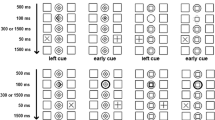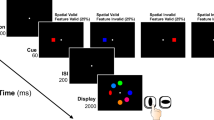Abstract
This study investigated the orienting of visual attention in rats using a 3-hole nose-poke task analogous to Posner, Information processing in cognition: the Loyola Symposium, Erlbaum, Hillsdale, (1980) covert attention task for humans. The effects of non-predictive (50% valid and 50% invalid) and predictive (80% valid and 20% invalid) peripheral visual cues on reaction times and response accuracy to a target stimulus, using Stimuli-Onset Asynchronies (SOAs) varying between 200 and 1,200 ms, were investigated. The results showed shorter reaction times in valid trials relative to invalid trials for both subjects trained in the non-predictive and predictive conditions, particularly when the SOAs were 200 and 400 ms. However, the magnitude of this validity effect was significantly greater for subjects exposed to predictive cues, when the SOA was 800 ms. Subjects exposed to invalid predictive cues exhibited an increase in omission errors relative to subjects exposed to invalid non-predictive cues. In contrast, valid cues reduced the proportion of omission errors for subjects trained in the predictive condition relative to subjects trained in the non-predictive condition. These results are congruent with those usually reported for humans and indicate that, in addition to the exogenous capture of attention promoted by both predictive and non-predictive peripheral cues, rats exposed to predictive cues engaged an additional slower process equivalent to human’s endogenous orienting of attention. To our knowledge, this is the first demonstration of an endogenous-like process of covert orienting of visual attention in rats.





Similar content being viewed by others
References
Azevedo EL, Squella SA, Ribeiro-do-Valle LE (2001) The early facilitatory effect of a peripheral spatially noninformative prime stimulus depends on target stimulus features. Braz J Med Biol Res 34(6):803–813
Bartolomeo P, Decaix C, Siéroff E (2007) The phenomenology of endogenous orienting. Conscious Cogn 16(1):144–161
Berger A, Henik A, Rafal R (2005) Competition between endogenous and exogenous orienting of visual attention. J Exp Psychol Gen 134(2):207–221
Bowman EM, Brown VJ, Kertzman C, Schwarz U, Robinson DL (1993) Covert orienting of attention in macaques. I. Effects of behavioral context. J Neurophysiol 70(1):431–443
Bushnell PJ (1995) Overt orienting in the rat: parametric studies of cued detection of visual targets. Behav Neurosci 109(6):1095–1105
Corbetta M, Shulman GL (2002) Control of goal-directed and stimulus-driven attention in the brain. Nat Rev Neurosci 3(3):201–215
Folk CL, Remington RW, Johnston JC (1992) Involuntary covert orienting is contingent on attentional control settings. J Exp Psychol Hum Percept Perform 18(4):1030–1044
Jonides J (1980) Towards a model of the mind’s eye’s movement. Can J Psychol 34(2):103–112
Jonides J (1981) Voluntary versus automatic control over the mind’s eye’s movement. In: Long JB, Baddeley AD (eds) Attention and performance ix, vol IX. Erlbaum, Hillsdale, NJ, pp 187–203
Jonides J (1983) Further toward a model of the mind’s eye’s movement. BPS 21(4):247–250
Juola JF, Koshino H, Warner CB, McMickell M, Peterson M (2000) Automatic and voluntary control of attention in young and older adults. Am J Psychol 113(2):159–178
Luck SJ, Vecera SP (2002) Attention. In: Pashler H, Yantis S (eds) Steven’s handbook of experimental psychology, vol 1. Sensation and Perception. Wiley, New York, NY, pp 235–286
McCormick PA (1997) Orienting attention without awareness. J Exp Psychol Hum Percept Perform 23(1):168–180
Müller HJ, Findlay JM (1988) The effect of visual attention on peripheral discrimination thresholds in single and multiple element displays. Acta Psychol (Amst) 69(2):129–155
Müller HJ, Humphreys GW (1991) Luminance-increment detection: capacity-limited or not? J Exp Psychol Hum Percept Perform 17(1):107–124
Müller HJ, Rabbitt PM (1989) Reflexive and voluntary orienting of visual attention: time course of activation and resistance to interruption. J Exp Psychol Hum Percept Perform 15(2):315–330
Phillips JM, Brown VJ (2000) Anticipatory errors after unilateral lesions of the subthalamic nucleus in the rat: evidence for a failure of response inhibition. Behav Neurosci 114(1):150–157
Phillips JM, McAlonan K, Robb WGK, Brown VJ (2000) Cholinergic neurotransmission influences covert orientation of visuospatial attention in the rat. Psychopharmacology (Berl) 150(1):112–116
Posner MI (1980) Orienting of attention. Q J Exp Psychol 32(1):3–25
Posner MI, Cohen Y (1984) Components of visual orienting. In: Bouma H, Bouwhuis DG (eds) Attention and performance X, vol 10. Erlbaum, Hillsdale, NJ, pp 531–556
Posner MI, Snyder CRR (1975) Attention and cognitive control. In: Solso RL (ed) Information processing in cognition: the Loyola Symposium. Erlbaum, Hillsdale, NJ, pp 55–85
Posner MI, Nissen MJ, Ogden WC (1978) Attended and unattended processing modes: the role of set for spatial location. In: Pick HL, Saltzman IJ (eds) Modes of perceiving and processing information. Erlbaum, Hillsdale, NJ, pp 137–158
Prinzmetal W, McCool C, Park S (2005) Attention: reaction time and accuracy reveal different mechanisms. J Exp Psychol Gen 134(1):73–92
Rosner AL, Mittleman G (1996) Visuospatial attention in the rat and posterior parietal cortex lesions. Behav Brain Res 79(1–2):69–77
Ward NM, Brown VJ (1996) Covert orienting of attention in the rat and the role of striatal dopamine. J Neurosci 16(9):3082–3088
Ward NM, Brown VJ (1997) Deficits in response initiation, but not attention, following excitotoxic lesions of posterior parietal cortex in the rat. Brain Res 775(1–2):81–90
Ward NM, Sharkey J, Marston HM, Brown VJ (1998) Simple and choice reaction-time performance following occlusion of the anterior cerebral arteries in the rat. Exp Brain Res 123(3):269–281
Warner CB, Juola JF, Koshino H (1990) Voluntary allocation versus automatic capture of visual attention. Percept Psychophys 48(3):243–251
Weese GD, Phillips JM, Brown VJ (1999) Attentional orienting is impaired by unilateral lesions of the thalamic reticular nucleus in the rat. J Neurosci 19(22):10135–10139
Wright RD, Richard CM (2000) Location cue validity affects inhibition of return of visual processing. Vision Res 40(17):2351–2358
Acknowledgments
The authors thank three anonymous reviewers and Dr. Bárbara K.A. Onishi for criticisms and comments that helped to improve an early version of the present study. This research was supported by grants from Fundação de Amparo à Pesquisa do Estado de São Paulo (FAPESP), Coordenação de Aperfeiçoamento de Pessoal do Ensino Superior (CAPES), and Conselho Nacional de Desenvolvimento Científico e Tecnológico (CNPq), Brazil.
Author information
Authors and Affiliations
Corresponding author
Rights and permissions
About this article
Cite this article
Marote, C.F.O., Xavier, G.F. Endogenous-like orienting of visual attention in rats. Anim Cogn 14, 535–544 (2011). https://doi.org/10.1007/s10071-011-0388-3
Received:
Revised:
Accepted:
Published:
Issue Date:
DOI: https://doi.org/10.1007/s10071-011-0388-3




